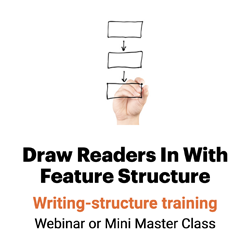‘From Tina Turner to Taylor Swift’
When Ian Jones needed to craft a — yawn! — diversity story for employees at Columbia Gas of Virginia, his first instinct was to go with a fact pack.

You can see Ian’s natural creativity peeking through with the concrete details in the headline and — buried deep but still breathing — in the lead.
But by the end of a recent Catch Your Readers Master Class, Ian had totally rewritten his piece from an inverted pyramid to a feature story. That basic structure lets the concrete details rise to the top.
Here’s his before and after:
1. Lead
Like (too) many of us, Ian was taught to cram all of the facts into the lead, so readers would get the key details before they stop reading after the first paragraph. Here’s how his opening paragraph looked:
You can see the problem with that: a lead that is so thick that most readers will stop reading before the first paragraph. Plus, Ian’s delightful concrete details get smothered in all of the not-so-interesting facts.
Instead of a fact pack, write a lead that draws readers in with a concrete detail or three. Don’t tell the whole story in the lead — that’s what the whole story is for — but write a lead paragraph that entices people to read the second paragraph.
Here’s how Ian handled that in his rewrite:
2. Nut graph
Inverted pyramids don’t have nut graphs, so neither did Ian’s original story.
When you don’t feel compelled to put all of the W’s in the lead, they need someplace to go. Ian moves them into the nut paragraph:
At 57 words, that’s still a little thick. What can you do in 25 words or less?
3. Background section
No background in the original story. But in the rewrite, Ian provides context for the story — the reason the diversity initiative is so important:
4. Body
In his first version, Ian emphasizes the event — what happened during the kickoff — in the body of his post:
“ERGs are an excellent way for employees to get involved in shaping the success of our company as well as their own personal success within NiSource,” explained Sasha Furdak-Roy, Business Planning and Strategy Manager and Virginia liaison for GOLD. “I would challenge any employee to read the missions of GOLD, DAWN, LEAD, and NiVETS and say that nothing resonates with them. All ERGs offer professional and personal development opportunities for every employee along with focused events geared towards recruiting and retaining diverse talent at NiSource. That’s why I’m a member of all four ERGs.” Other representatives participating in the panel discussion included Andrew Watson with LEAD, Gina Slaunwhite with DAWN, and Joe Mays with NiVETS.
The day continued with a training session delivered by Deloras called “Mixing It Up: The Changing Landscape Across Generations.” Deloras shared NGD employee demographics which reflect a workforce comprised of four generations. The multi-generational workforce presents both advantages and challenges, Deloras pointed out. NiSource has a talented pool of employees with varying perspectives and skill sets but there is also the possibility of misunderstanding between the generations. The training session highlighted differences between generations and gave attendees an understanding of how to turn these differences into strengths instead of perceiving them as barriers.
“Employees who have been here for a while have a lot of valuable knowledge and experience while younger employees are able to offer a new and fresh perspective. We all have something different to contribute” added Kristine Johnson, Lead Regulatory Analyst and new member of the Surf-n-Turf regional I&D council.
By the session’s end, CGV regional I&D councils and ERG representatives gained a better understanding of how they can work together to achieve their objectives in 2015. Employees interested in joining an ERG can visit the MySource Inclusion & Diversity page for more information.
In the second, he focuses on the impact: what the attendees learned that might be helpful to you, too:
Tips for working with other generations
Millennials
- Respect flexible schedules. They like to get the job done but in a way that’s convenient for them. Consider flex hours and accommodating personal needs.
- Give them space. They want direction but don’t want to be micromanaged. Keep an eye on things but give them space to be creative.
Gen X
- Give them space. These employees tend to be more independent, so respect their personal space.
- Clarify expectations. Generation X takes a more hands-off approach to managing. Ask to clarify expectations if you don’t have enough direction.
Baby Boomers
- Use direct communication. Baby boomers prefer direct, face-to-face conversation instead of long emails.
- Fully explain changes. Boomers are likely to resist change unless you fully explain the benefits of those changes.
Note also the crisp paragraphs in the final version compared to the 100-plus-word-long ones in the original.
5. Wrapup
The great thing about inverted pyramids is that you don’t have to craft a conclusion. When you’re finished, you just stop typing. That’s what Ian did in his original.
But the feature-style story structure demands an ending. In his revision, Ian summarizes the story in the wrapup, or the penultimate paragraph, topped as it should be with a subhead to separate the body from the ending:
I&D Teams and ERGs are your tools for growth
You can expect to see more tips on how to best interact with your fellow coworkers throughout the year. Sasha Furdak-Roy, Virginia liaison for GOLD, says “working with ERGs and your I&D Councils helps shape the success of our company and your own success within it.”
6. Kicker
Ian ends with bang and circles back to the top with a concrete details kicker that leaves a lasting impression:
Focus on the reader.
“Thinking about the reader from the start really changes everything — from story angle to story structure to sentence length,” Ian says. “Instead of approaching writing from the perspective of a writer, I now think about whether I’m writing a story I would want to read.’”

Leave a Reply